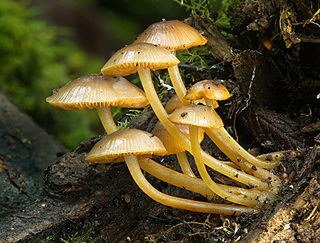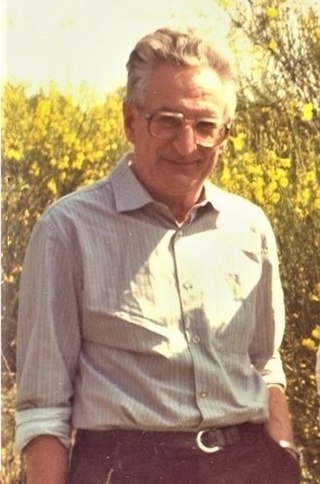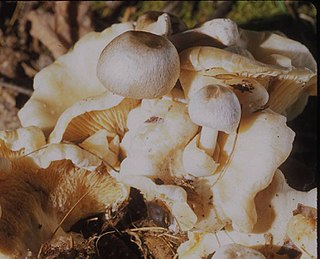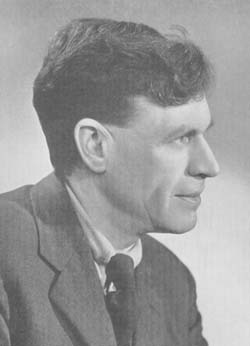
Mycology is the branch of biology concerned with the study of fungi, including their taxonomy, genetics, biochemical properties, and use by humans. Fungi can be a source of tinder, food, traditional medicine, as well as entheogens, poison, and infection. Mycology branches into the field of phytopathology, the study of plant diseases. The two disciplines are closely related, because the vast majority of plant pathogens are fungi. A biologist specializing in mycology is called a mycologist.

Rolf Singer was a German mycologist and taxonomist of gilled mushrooms (agarics).
The North American Mycological Association (NAMA), is a non-profit organization of amateurs and professionals who are interested in fungi, including mushrooms, morels, truffles, molds, and related organisms. NAMA aims "to promote, pursue, and advance the science of mycology."

Alexander Hanchett Smith was an American mycologist known for his extensive contributions to the taxonomy and phylogeny of the higher fungi, especially the agarics.

Worthington George Smith was an English cartoonist and illustrator, archaeologist, plant pathologist, and mycologist.
Gertrude Simmons Burlingham was an early 20th-century mycologist best known for her work on American Russula and Lactarius and pioneering the use of microscopic spore features and iodine staining for species identification.

Meinhard Michael Moser was an Austrian mycologist. His work principally concerned the taxonomy, chemistry, and toxicity of the gilled mushrooms (Agaricales), especially those of the genus Cortinarius, and the ecology of ectomycorrhizal relationships. His contributions to the Kleine Kryptogamenflora von Mitteleuropa series of mycological guidebooks were well regarded and widely used. In particular, his 1953 Blätter- und Bauchpilze [The Gilled and Gasteroid Fungi ], which became known as simply "Moser", saw several editions in both the original German and in translation. Other important works included a 1960 monograph on the genus Phlegmacium and a 1975 study of members of Cortinarius, Dermocybe, and Stephanopus in South America, co-authored with the mycologist Egon Horak.

Volvariella surrecta, commonly known as the piggyback rosegill, is an agaric fungus in the family Pluteaceae. Although rare, the species is widely distributed, having been reported from Asia, North America, Northern Africa, Europe, and New Zealand. The fungus grows as a parasite on the fruit bodies of other gilled mushrooms, usually Clitocybe nebularis. V. surrecta mushrooms have white or greyish silky-hairy caps up to 8 cm (3.1 in) in diameter, and white gills that turns pink in maturity. The stipe, also white, is up to 9 cm (3.5 in) long, and has a sack-like volva at its base.

Cecil Terence Ingold CMG was "one of the most influential mycologists of the twentieth century". He was president of the British Mycological Society where he organised the first international congress of mycologists. An entire class of aquatic fungi within the Pleosporales, the Ingoldian fungi, were named after him, although recent DNA studies are changing the scientific names.

The Fungus Federation of Santa Cruz (FFSC) is a North American mycological club that evolved as a result of David Arora’s mushroom classes and early Fungus Fairs in the Santa Cruz, California area in the 1970’s.
Raffaele Ciferri was an Italian botanist, agriculturalist and mycologist.
George Baker Cummins was a notable American mycologist and was considered an authority on the rust fungi. At his death he was the last surviving charter member of the Mycological Society of America.
Roy Watling, PhD., DSc, FRSE, F.I.Biol., C.Biol., FLS is a Scottish mycologist who has made significant contributions to the study of fungi both in the identification of new species and correct taxonomic placement, as well as in fungal ecology.
Kenneth A. Harrison was a Canadian mycologist. He was for many years a plant pathologist at what is now the Atlantic Food and Horticulture Research Centre in Nova Scotia. After retirement, he contributed to the taxonomy of the Agaricomycotina, particularly the tooth fungi of the families Hydnaceae and Bankeraceae, in which he described several new species.

Fungal Diversity Survey, or FunDiS, is a nonprofit citizen science organization formerly known as North American Mycoflora Project, Inc. FunDiS aims to document the diversity and distribution of fungi across North America “in order to increase awareness of their critical role in the health of ecosystems and allow us to better protect them in a world of rapid climate change and habitat loss.” The project encourages amateurs, working with professionals, to contribute observations to online databases vetted by experts, and to collect and document fungi for DNA barcoding. Fungal Diversity Survey, Inc. is a Charitable 501(c)(3) organization registered in Indiana, USA.
Lois Long was an American amateur mycologist, best known for her illustrations and textile designs featuring mushrooms and other forms of nature.
Bessie Bernice Kanouse was an American mycologist. The standard author abbreviation Kanouse is used to indicate this person as the author when citing a botanical name.
Brian Martin Spooner is an English mycologist who was head of mycology at the Royal Botanic Gardens, Kew.

Gary Lincoff (1942–2018) was an American mycologist and naturalist. Lincoff taught at the New York Botanical Garden for over 40 years and authored numerous books and field guides on mushrooms.
Eugenia Bone is an American food and nature writer, as well as a chef and amateur mycologist. Her work has appeared in the New York Times, Wall Street Journal, Food & Wine, Saveur and the BBC Science Focus. Bone is the author of numerous books on food and mushrooms.










